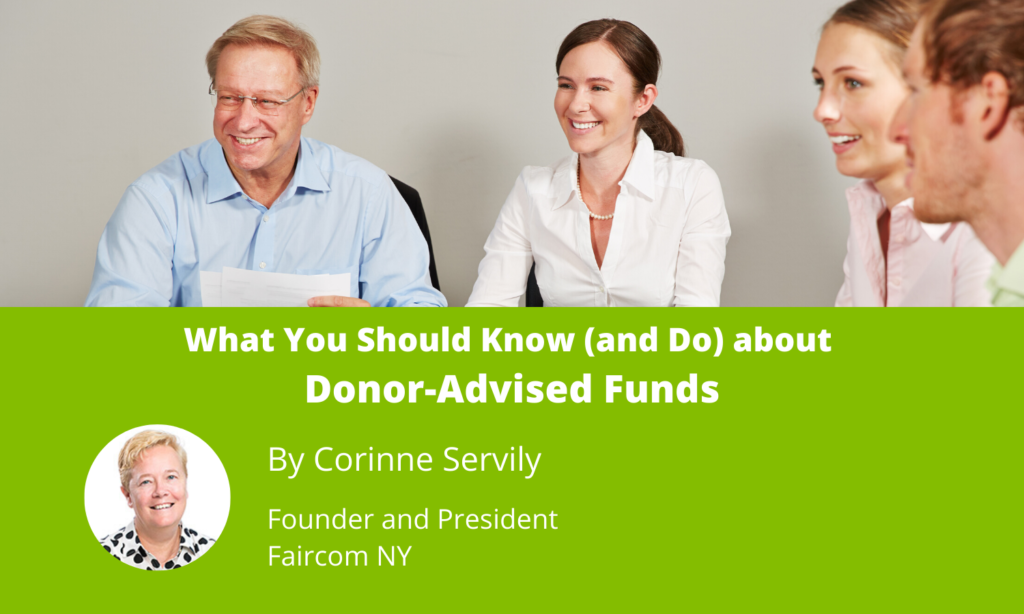If you’re not familiar with Donor-Advised Funds (DAFs), it’s time to get started. This charitable giving vehicle holds great fundraising potential for your nonprofit, and understanding how you can unlock it will be game-changing.
DAFs contribute to 13% of overall giving today — more than digital, which is 8.5%. Additionally, more than 130 billion dollars in DAFs are just waiting to be distributed. And, on top of that, DAFs appear to be somewhat recession proof! Nonetheless, a lot of nonprofits don’t pay much attention to them. DAFs are absent on their websites, in their appeals and overall in fundraising strategies.
But if DAFs are underrated, it might be because most people don’t really know how they work and how to use them to increase fundraising results. So we wanted to give you some insights and a few tips.
What is a Donor-Advised Fund (DAF)?
A DAF is a giving vehicle established at a public charity created to manage donations on behalf of organizations, families, or individuals. It allows donors to make a charitable contribution and receive an immediate tax deduction. To participate in a DAF, a philanthropist must open an account in the fund and deposit cash, securities, or other financial instruments. Although they surrender ownership of anything they put in the fund, donors retain advisory privileges over how it is invested and distributed to charities.
What are the benefits for donors?
- Convenience. Instead of having to personally track all their giving, some people use DAFs as a centralized hub to simplify their philanthropy. One contribution can fund multiple donations to an advisor’s favorite charity or charities.
- Increased giving potential. Assets in a DAF are invested tax-free, enabling many advisors to grant much more to charity in the long run.
- Flexibility. In the wake of crises such as hurricanes and the coronavirus pandemic, DAF advisors can respond quickly. Charitable resources in a DAF are “primed” and ready for rapid disbursal.
- New charitable assets. Most sponsoring organizations can accept donations of non- cash assets, such as appreciated securities. These often overlooked charitable assets pull additional resources into the philanthropic community. In fact, Fidelity Charitable reports that 62% of donations to DAFs come from non-cash assets.
- Tax benefits. Donors have the ability to bundle assets and make a larger gift when it is most advantageous from a tax perspective. This has become increasingly popular with tax legislation that reduces the number of households itemizing their returns.
What are the benefits for a nonprofit?
Identifying who among your supporters is engaged in a DAF and trying to onboard new DAF philanthropists to your charity is key to increasing your revenue today and in the long run.
- The capacity for giving of people using a DAF account might be substantially greater than you think.
- Research tells us that DAF donors have a high propensity to make planned gifts.
How can you onboard DAF donors to your charity?
- Flag all DAF contributions. Everyone who gives from a DAF giving account should be fast-tracked for major donor research and cultivation, regardless of the size of the grant.
- All DAF advisors should be included in your gift planning outreach.
- Send a cultivation survey by email to identify who on your file has a DAF.
- Make it easy to give through a DAF and promote it on various channels. Have a dedicated page on your website, talk about it on social media, mention it in email appeals as a way to give, etc.
- DAF donors tend to be sophisticated. Engaging them in a serious manner by sharing information today can help shape their DAF giving tomorrow. Develop high quality collateral around your mission and impact. Your answers to these questions from Fidelity Charitable can provide great content:
- What’s your most successful program and why?
- What are areas of opportunity for your organization?
- Do you have a strategic plan?
- What key things are you trying to accomplish in that plan?
- Is there anything that you wish more people knew about your organization or the issues you are trying to solve?
- Where does most of your funding come from?
- What percentage of your budget comes from private donations, and what do private donations help you to do that your other sources of funding don’t cover?
- What would make the greatest difference in helping your organization get better at what it does?
- How do you measure and report on the effectiveness of your programs?
- What are the main obstacles that stand between you and your mission, and how do you plan to overcome them?
- Do you regularly have the resources to cover your budget? Why or why not?
- How would you compare your programs and results to others working in the same field?
If you want to learn more about DAFs and how to unlock their fundraising potential, we are here to help. You can contact us at any time.
Sources
- What is a donor advised fund. Fidelity Charitable.
- What is a DAF. DAF Direct.

